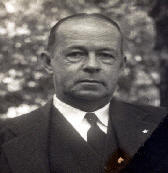
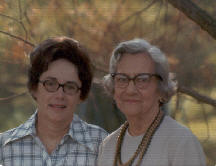
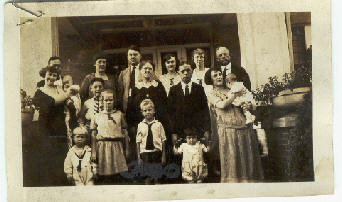
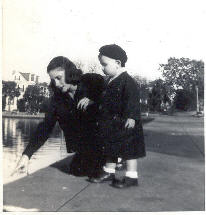
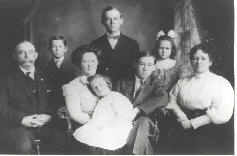



Walter F. McClure Family McClure Family 1923 Jeanne McClure Sanders with son Robert McClure Jeanne McClure Sanders & Helen Jackson McClure
Mrs. Louise “Biddy” Hammett has written two books about Carrie Fall Benson - and another about the Hammett Family. Congratulations, Biddy!
THE PEN OF CARRIE FALL BENSON
discovered and annotated by Louise Barfield Hammett
HONORS--- AWARDS --- PUBLISHED WORK
belonged to an important Georgia Poet, the First Librarian at LaGrange College
CARRIE FALL BENSON (1891-1949)
A new anthology, The Pen of Carrie Fall Benson, by Louise Barfield Hammett,
presents Carrie Fall Benson’s compete register of poetry, plays, essays, and short stories,
published (2009) by LaGrange College. [due for release Autumn 2009]
discovered and annotated by Louise Barfield Hammett
HONORS-
belonged to an important Georgia Poet, the First Librarian at LaGrange College
CARRIE FALL BENSON (1891-
A new anthology,
presents Carrie Fall Benson’s compete register of poetry, plays, essays, and short stories,
published (2009) by LaGrange College. [due for release Autumn 2009]
Former Poet Laureate of Georgia Bettie Mixon Sellers (1997-2001), in the books’ Foreword wrote: ” Early and late, girl and woman, the theme is repeated in all of the registers of this woman who represents the best of those of us who were so fortunate to have been associated with LaGrange College over the years. She sings with many notes: some songs carry an undertone of sadness, loss of a mother, loss of a young love. At other times, the notes echo the recurrence of spring and daffodils (interestingly, more spring than other seasons).
“In a very realistic voice, she will write of the times of the Civil War, so recently passed from the plantations and slavery. Her dialogue of Mammy and maid, other voices of rural and milltown characters are true. I was reminded of the language that Joel Chandler Harris used in his many stories and novels of the same period. There are the fairies, companions of a lonely child who built fantasies from her dreams of the little people who dance in spring gardens. Poems about people and events, short plays once performed at the college during her lifetime came from her pen.
“Little did I know when I walked from English class. the path to the library that close by, waiting to be discovered was such a treasure trove of words and ideas left behind by Carrie Fall Benson. A superb representative of a fine college, Benson was an early writer, ahead of her time, a period when women were coming into their own.
A century ago, Carrie Fall Benson’s poetry and short stories, written from 1907, began to have recognition. Her large body of work received much recognition and awards, following noteworthy publications, until her death in 1949.
The biography, I Must Sing! The Era With Carrie Fall Benson, by Louise Barfield Hammett, was also published by LaGrange College (2007). After finding the immense cache of Benson’s creative writing, Hammett says she wrote that title, wanting to refresh the world of literature, with the importance of the LaGrange writer. The story of Carrie Fall Benson’s interesting life, her autobiographical literature, the large amount of recognition the woman’s published writing received, and outstanding awards are herewith outlined. The body of her work belongs with Georgia’s fine canon of literature. LaGrange newspapers began publishing the work of Carrie Fall Benson in the first quarter of the 20th Century and student newspapers papers, at LaGrange College, began publishing her work in 1922, after she became the first official librarian at the school.
The March 1934 issue of the North Carolina Poetry Review, published at Oxford, North Carolina, by the North Carolina Poetry Society, included Benson's poem, "In An Old Trunk." A Landrover, Maryland, publication, Sonnet Sequences, edited by Murray L. Marshall, chose Carrie Fall's "Cat Sonnet" for its publication’s 1934 Sonnet Lovers' Calendar.
In April, 1934, Hilltop Magazine, published "Jungle Around the Corner," having a theme that reveals Benson's realistic familiarity with African-American communities. Showing sympathy for the people she knew so well, she wrote in this poem, ". . .whose tamed lives on our own so closely verge/ There is no answer to their rhythmic hunger/ When phantom tom-toms beat upon the night."
Also, in 1934, the Texas magazine, Kaleidograph, published "West Wind Blowing," and The Atlanta Journal (Georgia) began regularly publishing her verse in the way LaGrange papers had published her poetry from her youth.
This same year, editors of Kaleidograph published an anthology entitled, Merry-Go-Round , which included Benson's poem, "West Wind Blowing" which had been published by the company, in its June 1934 issue of Kaleidograph, to be continually reprinted in newspapers in several western states as well and other places.
The next year, after February 21, the publishing impetus of Carrie Fall Benson's writing increased, following a successful production of The Music Box at LaGrange College, by the school, at a time the college presented the Curtain Raisers, in a trilogy of plays, Heard in Camera by Essex Dane, Rolls of Salt by Nancy Boyd, with Benson's The Music Box.
"Nicholas II,” found in Benson’s collection that lay hid, in a LaGrange College library storage room file, for more than forty years, following her death, was published in a Gastonia, North Carolina magazine, The North Carolina Poetry Review (January-February 1935) and selected for Benson’s brief anthology, Every Year An April (1937).
In 1935, Caroline Fall Benson, appreciating the town's total acceptance of herself and her work, created a Christmas fantasy, The Innkeeper's Daughter. She let the pay be a Christmas gift dedicated to her "much loved hometown." The town attended in mass when the play, based on The Holy Night, was produced December 15, 1935, at LaGrange College. Four years later, the play was produced by Episcopal young people at Saint Mark's Church, in LaGrange, while it was also performed by the Valley High Glee Club, at Fairfax, Alabama and other places.
The Atlanta Writer's Club made Carrie Fall Benson its Honored Poet, at the organization's March 1936 dinner, where various Benson works were read. At about the same time, "Revenant," also in the anthology, Every Year An April, was included, in the anthology Diadem of the Muse, published by Adastra Publishers, of New York, which also included verses from poet laureates of New Hampshire and Vermont. This significant verse from Carrie Fall Benson's persona identifies her freed self returning from the dredges of death.
The verse signifies her spirit approaching Ben Carter, a man she loved throughout her life. The publication, by Adastra brought editorial commentary, on the editorial page of The Atlanta Journal, March 18, 1936. That same day, LaGrange College honored Carrie Fall Benson with a Chapel Program, at which Mrs. George Hughlet gave a biographical sketch of Benson's life. Also, in March 1934, Kaleidograph Press Dallas, Texas, in its Merry-Go-Round, an annual anthology, published "Seaside Visit."
LaGrange College alumnae, at Fairburn, Georgia, asked Carrie Fall Benson to be their Honored Guest, July 13, 1936. The American magazine of Cohoes, New York, published "Exit," (Every Year An April) Kaleidograph Press), as did the The Literary Digest, January 11, 1936 issue.
After Kaleidograph Press of Dallas, Texas, had published Carrie Fall's poetry for more than a dozen years in the company's quarterly publication, The Harp, arrangements were made for the Press to publish ninety of Carrie Fall Benson's poems, in an anthology of less thanpublished by Bozart and Contemporary Verse, The Harp, The Voice, Kaleidograph, Inspirations, Verse-Craft , Sonnet Sequences, Blue Moon, Will-o'-the-Wisp , North Carolina Poetry Review, Diadem of the Muse (an anthology), Poems of Trees, a Sidney Lanier Memorial, The Atlanta Journal, and The Charlotte (N.C. ) Observer.
The small anthology, sold at Davidson-Paxon and Miller’s Book Store of Atlanta for the price of $1.50, with Carrie Fall donating the net proceeds to the library fund at LaGrange College. The LaGrange College Alumnae met November 1937 and decided to help sell the little book. One third of the proceeds would go to the LaGrange College library fund that needed to purchase enough books to have the library meet standards for the college to gain much needed accreditation and two-thirds going to Carrie Fall Benson.
Carrie Fall Benson was honored, at a fiftieth birthday celebration, using a secretly planned Program, December 16, 1941. She thought she was to going to hear her play, The Fiddlin' Feller, read by Sarah Veatch and some of her Christmas read poems only before the college girls. The well kept secret was indeed a surprise. The evening was a major celebration. A huge gathering of the town came to officially honor her! Recognition, awards and honors continued coming to Carrie Fall Benson. “Desert Wind? Was awarded the best poem of the year in 1940 by The Atlanta Writer’s Club.
The Atlanta Constitution published a list of Literary Awards that were selected by Gertrude Gore, president of the Miami Branch of American Pen Women, and Mrs. Walter Greenwall, a prominent Miami poet. Remaining very active in the Georgia Writer’s Club, the Georgia Poetry Society, and the American Poetry Society, Benson was early in exposing false values and prejudice in themes of her writing, before Edith Wharton’s Age of Innocence and Gertrude Stein, Paris, sought to reach basic conscience, in the themes of their writing. “Letters to Thalia" and "Greater Glory," Benson’s serious prose portrayed Americans, aligned with characters belonging to those that Wharton and Stein would write into their material. To come, were more Twentieth Century modernist writers, such as Theodore Dreiser with his Sister Carrie, Sinclair Lewis writing Main Street and about Babbitt, and F. Scott Fitzgerald writing The Great Gatsby and Tender is the Night. Benson’s characters, as early as 1907, criticized false values that came later from these and other writers who obtained greater notoriety, without their work being cloistered in a long forgotten file, in the way Benson’s work was obscured.
Carrie Fall was already writing about such things, belonging to mankind when Harold Clurman and the New York theater began to expound the theory: Life is a game---enjoy it; everyone on earth loses in that finally mankind dies to all things human.
The attitude of Carrie Fall Benson and the story of her life are within the body of her work. Her lingering essence echoes throughout her lines. Within the body of her work, readers can understand how she believed her spirit lives forever and her fervent heart continues to beat in the eternity of heaven; her spirit lives on earth within her writing. From before the little book’s publication, Bensons poetic themes of Divine communion and forgiveness were often used in the bulletin of First Baptist Church, LaGrange, Ga.
In 1946, the LaGrange College annual yearbook, The Quadrangle, was dedicated to Carrie Fall Benson. In March of 1948, Carrie Fall started getting together her credentials, for membership in the Atlanta Chapter of the National League of American Pen Women. That same year, writer Lila Moore Keen, Georgia, historian Louise Frederick Hays, and a noted landscape garden lecturer and writer, Edith Henderson also were invited to be new members. Carrie Fall Benson’s had membership in the Atlanta Writer’s Club and other important poetry and writing societies that had been organized in Georgia, meeting at both Emory and Oglethorpe University. She appreciated Oglethorpe, University of Atlanta, and the school’s contribution to American literature, under Dr. Thornwell Jacobs’ presidency. Dr. Jacobs brought a number of writer’s clubs to meet there and allowed the college to sponsor several literary magazines and publications. Here Benson became well acquainted and corresponded with a variety of the country’s most important writers.
After meeting Booth Tarkinton, she sent one of her poems to him with a complimentary note about his recently published Little Orvie, Tarkington’s wife wrote her a thank you note. The reformer, Edwin Markham, founder of the American Poetry Society, was made honorary president of the (original) Poetry Society of Georgia.
In the same volume of Versecraft that published Markham’s “Man with a Hoe,” Verscraft, published at Oglethorpe, chose to also publish Benson’s poem “Generation,” a loving tribute to her childhood nurse, Ann, along with other important Georgia writers: Daniel Whiteside Hickey, president of the Atlanta Writer’s Club; poet Linda Wilson Turner; short story writer and poet Minnie Hitt Mooty; and Mary Brent Whiteside, professor at Oglethorpe and editor of Bozart and Contemporary Verse.
Dr. Wightman F. Melton, editor of the first of many volumes entitled, Poems of Trees, A Memorial to Sidney Lanier, included Bensons poems in volumes one and five. One of Benson’s poems Dr. Melton included was “Judas Tree.”
The Cora Smith Gould Award, which became a coveted award offered by Westminister Magazine, was won by Carrie Fall Benson more than once. In the spring of 1945, she received the Gould Award from the literary quarterly, Westminister, for the poem, “There s Loneliness,” winning over native of West Point, Georgia, Dr Anderson M. Scruggs, to become a well known poet of Atlanta and Marcel Brown, president of the Atlanta Chapter
of American Pen Women, for whom the Georgia Poetry Society named its annual award for best poem of the year. The last time Carrie Fall Benson won the award was in the Fall of 1948, for “Gray Days on Campus.”
of American Pen Women, for whom the Georgia Poetry Society named its annual award for best poem of the year. The last time Carrie Fall Benson won the award was in the Fall of 1948, for “Gray Days on Campus.”
Carrie Fall Benson’s died at Wisteria Cottage, August 30, 1949.On April 25, 1950, the Atlanta Chapter of American Pen celebrated the life of Carrie Fall Benson with a memorial service at LaGrange College.
The late playwright and director, Charlie Jim Jones cited Willa Cather’s explanation of emotions that are felt when reading literature, holds true with readers of Carrie Fall Benson’s witing. Cather said, “Whatever is felt upon the page without being specifically named there— that we may say, is created." The creative energy of Carrie Fall
Benson brings forth her essence with personal realist qualities which establish the literary legacy of Caroline Fall Benson as an early writer of realism in the Twentieth Century contribution to American literature, under Dr. Thornwell Jacobs’ presidency. Dr. Jacobs brought a number of writer’s clubs to meet there and allowed the college to sponsor several literary magazines and publications. Here Benson became well acquainted and corresponded
with a variety of the country’s most important writers.
Benson brings forth her essence with personal realist qualities which establish the literary legacy of Caroline Fall Benson as an early writer of realism in the Twentieth Century contribution to American literature, under Dr. Thornwell Jacobs’ presidency. Dr. Jacobs brought a number of writer’s clubs to meet there and allowed the college to sponsor several literary magazines and publications. Here Benson became well acquainted and corresponded
with a variety of the country’s most important writers.
The Pen of Carrie Fall Benson and I Must Sing! The Era With Carrie Fall Benson are available at LaGrange College Bookstore and online. LaGrange College Bookstore Price -
I Must Sing! The Era with Carrie Fall Benson
-
The book is a biographical history of LaGrange native, Carrie Fall Benson (1891-1949), whose father and grandfather Benson were Montgomery merchants, in the old Exchange Hotel building, during the latter part of the 19th Century. Her parents spent their early marriage at Decatur.
Eustace Conway Benson, of Montgomery, went to Decatur, in 1887, immediately following his marriage to Lucie Fauntleroy Todd of LaGrange, and opened Benson's Haberdashery. Lucie Fauntleroy Todd Benson, was a descendant of Alfred the Great, “University Wit” Robert Greene, William Lovelace, and Rev. Gen. Nathanael (the way he spelled his name) Greene.
Carrie Fall Benson was a playwright, poet, and short story writer. She became the first librarian at LaGrange College in 1922. (According to the Library of Congress, LaGrange College, founded in 1931, is the 3rd oldest women's college in the United States, the oldest being Salem College in North Carolina and Lindenwood in Missouri, respectively.)
During her life, Carrie Fall Benson won every award and acclamation offered to women literary writers, except being a poet laureate and winning a Pulitzer, yet she may have inspired a winner of one of those. She was widely published from Texas, North Carolina, in New York, and Chicago, and in every poetry publication of her day, as well as the Atlantic Review and others. Her work is in several volumes of the Sidney Lanier Memorials.
Because the body of work by Carrie Fall Benson was long believe to have been burned, very little was heard about her, after her death in 1949. In the late 1980s, Biddy Hammett was fortunate in finding a four drawer filing cabinet, filled with her original manuscripts, in the basement of the LaGrange College Library.
Work on her book has been ongoing for 20 years. LaGrange College supported the publication of the text that provides Miss Benson's own history of the college (the only known written history of the school) as well as the only history of the old Baptist College at LaGrange that became defunct in 1917.) In addition, a general synopsis of early education in the region is included in the text, with a summary of Southern literary writers, where Carrie Fall Benson is placed among the earliest women writers in the genre of realism.
What Yankee troops, under General Wilson and Col. Oscar LaGrange did in Alabama and Georgia is expanded in the text, with several of Benson's relatives being important in the Confederate Congress. Her great-grandfather's sister married Clement Clay. There is much other historical information related to Georgia, Alabama history, and history of the South, along with elements of national history. Tombstones and other documentation show Carrie Fall Benson's Palmer Gr- gr- grandparents were friends of Georgia Washington.. Washington actually named her gr gr mother Mildred Washington Palmer, for his little sister, who had died. There is a history, of Eufaula, Alabama's colorful early cotton broker, William Flewellen Robinson, whose son established Robinson-Humphrey Brokerage and whose grandson brought American Express into the company, that brings that family into view for modern readers.
Decatur, Alabama of the late 1880s is introduced, with a chapter entitled, "The Bensons of Decatur, Alabama:" Dr. Foster Benson (wf Susan Seay, also Benson's relative), the 5,000 acres purchased by Major E. C. Gordon that surrounded Decatur, plank sidewalks, the McCartney Hotel, railroad development, river boat traffic, with the river boat captain, J. M. Todd (her relative), being then a five time major of the fast growing town.
Perhaps, the most important thing in the text are the Appendixes that provide a large amount of Benson's writing. She was one of the earliest writers of realism in the United States, beginning when she was the age of sixteen. A manuscript, The Pen of Carrie Fall Benson, containing the body of her work will hopefully be forthcoming.
The entire text further presents a history of the southeastern region, including, Muscogee Creek Indian history, DeFuniak Springs and Mariana, Florida, during the Florida Boom. Much about the development of folk drama that developed in North Carolina correlates with education in the South, the development of American literature, and historical personalities, who created the South as it is known today. Also railroad development from Pine Mountain, Columbus, to Florida and other Alabama railroads are seen with the Benson merchants of Montgomery and Decatur, Alabama.
I Must Sing! The Era with Carrie Fall Benson has an introduction by Dr. Stuart Gulley, President of LaGrange College. The academic editor was former head of Columbus State University History Department, Dr. Hugh I Rodgers. There are 416 pages of text; 37 pages of end notes, 65 pages with appendixes; a 6 page bibliography, and a 29 page comprehensive index.
The book may be purchased online or by telephone, using a credit card, [(706) 880-8215] from LaGrange College Bookstore @ $29.95, plus shipping."

